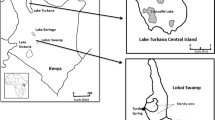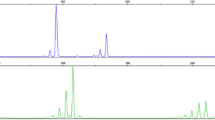Abstract
To study genetic variation in Indian populations of tilapia, Oreochromis niloticus, both truss morphometrics and genetic characterization have been performed. In the present study, 88 individuals from two farm populations (GIFT and West Bengal) and one reservoir population (Gujarat) were selected to analyse variations at ten morphometric landmarks and eight microsatellite loci. Truss morphometric analysis showed PCI, PCII, and PCIII expressing 29.1%, 21.36%, and 15.48% of the variance, respectively. Results showed no clear shift in shape between the studied populations of O. niloticus, indicating low morphological variability among them. The number of microsatellite alleles ranged from 3 to 9, while expected heterozygosity (HE) and observed heterozygosity (HO) values ranged from 0.56 (WB) to 0.68 (Guj) and 0.59 (GIFT) to 0.72 (Guj), respectively. The Gujarat and West Bengal populations had the smallest pairwise distance (0.0123) between them, indicating that they were genetically closer. Individuals from GIFT, however, showed the largest distance from the other populations. DNA marker variations revealed the highest genetic variability in the Gujarat population and the lowest variability in the GIFT population. The results of this study will help establish a base population for genetic improvement program and conservation of wild populations.





Similar content being viewed by others
Data availability
No data availability report required for this study as all the informations were provided in the text.
References
Abdul-Muneer PM (2014) Application of microsatellite markers in conservation genetics and fisheries management: recent advances in population structure analysis and conservation strategies. Genet Res Int 2014:1–11
Allendorf FW (1988) Conservation biology of fishes. Conserv Biol 2:145–148
Anon (2015) Guidelines for responsible farming of Tilapia in India. National Fisheries Development Board
Avise JC, Helfman GS, Saunders NC, Hales LS (1986) Mitochondrial DNA differentiation in North Atlantic eels: population genetic consequences of an unusual life history pattern. PNAS 83:4350–4354
Bookstein FL, Chernoff B, Elder RL, Humphries JM, Smith GR Jr, Strauss RE (1985) Morphometrics in evolutionary biology: the geometry of size and shape change, with examples from fishes. Q Rev Biol. https://doi.org/10.1086/415179
Cadrin SX (2005) Morphometric landmarks. Stock identification methods. Elsevier, pp 153–172
Cadrin SX, Friedland KD (1999) The utility of image processing techniques for morphometric analysis and stock identification. Fish Res 43:129–139
Carvalho GR, Pitcher TJ (2012) Molecular genetics in fisheries. Springer, Netherlands
Das SP, Bej D, Swain S, Mishra CK, Sahoo L, Jena JK, Jayasankar P, Das P (2014) Population divergence and structure of Cirrhinus mrigala from peninsular rivers of India, revealed by mitochondrial cytochrome b gene and truss morphometric analysis. Mitochondrial DNA A 25:157–164
Das SP, Swain S, Jena J, Das P (2018) Genetic diversity and population structure of Cirrhinus mrigala revealed by mitochondrial ATPase 6 gene. Mitochondrial DNA A 29:495–500
De Silva SS (2004) Tilapias as alien aquatics in Asia and the Pacific: a review. Food and Agriculture Organization of the United Nations, 9789251052273, FAO fisheries technical paper, https://books.google.com.tw/books?id=EBu_HkKo0y0C
Dey MM (2000) The impact of genetically improved farmed Nile tilapia in Asia. Aquac Econ Manag 4:107–124
Duong TY, Scribner KT (2018) Regional variation in genetic diversity between wild and cultured populations of bighead catfish (Clarias macrocephalus) in the Mekong Delta. Fish Res 207:118–125
Eknath AE, Dey MM, Rye M, Gjerde B, Abella TA, Sevilleja R, Tayamen MM, Reyes RA, Bentsen HB (1998) Selective breeding of Nile tilapia for Asia. In: 6th World Congress on Genetics Applied to Livestock Production, vol. 27. pp 89–96
Elliott NG, Haskard K, Koslow JA (1995) Morphometric analysis of orange roughy (Hoplostethus atlanticus) off the continental slope of southern Australia. J Fish Biol 46:202–220
Excoffier L, Laval G, Schneider S (2005) Arlequin (version 3.0): an integrated software package for population genetics data analysis. Evol Bioinfo 1:117693430500100000
Fagbemi MN, Pigneur LM, Andre A, Smitz N, Gennotte V, Michaux JR, Melard C, Laleye PA, Rougeot C (2021) Genetic structure of wild and farmed Nile tilapia (Oreochromis niloticus) populations in Benin based on genome wide SNP technology. Aquaculture 535:736432
Falush D, Stephens M, Pritchard JK (2007) Inference of population structure using multilocus genotype data: dominant markers and null alleles. Mol Ecol Notes 7:574–578
FAO (2020) The state of world fisheries and aquaculture 2020. Sustainability in action. Rome
Ferguson A (1989) Genetic differences among brown trout, Salmo trutta, stocks and their importance for the conservation and management of the species. Freshw Biol 21:35–46
Ferguson AJBT, Taggart JB, Prodöhl PA, McMeel O, Thompson C, Stone C, Mcginnity P, Hynes RA (1995) The application of molecular markers to the study and conservation of fish populations, with special reference to Salmo. J Fish Biol 47:103–126
Frankham R (1996) Relationship of genetic variation to population size in wildlife. Conserv Biol 10:1500–1508
Galman OR, Avtalion RR (1983) A preliminary investigation of the characteristics of red tilapias from the Philippines and Taiwan. In: Proceedings of the International Symposium on Tilapia in Aquaculture. Tel-Aviv Univ. Press Tel-Aviv. pp 13–18
Galman OR, Cariño VS (1979) Developmental expression of esterase isozymes in Tilapia nilotica. Kalikasan Philipp J Biol 8:13–22
Galman OR, Moreau J, Hulata G, Avtalion RR (1988) The use of electrophoresis as a technique for the identification and control of tilapia breeding stocks in Israel. Pullin T, Bhukaswan T. pp 177–81
Gu DE, Mu XD, Song HM, Luo D, Xu M, Luo JR, Hu YC (2014) Genetic diversity of invasive Oreochromis spp. (tilapia) populations in Guangdong province of China using microsatellite markers. Biochem Syst Ecol 55:198–204
Hammer O, Harper DA, Ryan PD (2001) Palaeontological statistics software package for education and data analysis. Palaeontol Electron 4
Johnson C, Sarkar UK, Koushlesh SK, Das AK, Das BK, Naskar BK (2020) Population structure of Nile tilapia and its impact on fisheries of a tropical impacted reservoir, Central India. Environ Sci Pollut Res 27:29091–29099
Johnson C, Sarkar UK, Koushlesh SK, Das AK, Das BK, Naskar BK (2022) Fish assemblage, ecosystem status and potential impact of Nile Tilapia in Halali Reservoir of Central India. Environ Dev Sustain 24:7753–7775
Kajungiro RA, Palaiokostas C, Pinto FA, Mmochi AJ, Mtolera M, Houston RD, De Koning DJ (2019) Population structure and genetic diversity of Nile tilapia (Oreochromis niloticus) strains cultured in Tanzania. Front Genet 10:1269
Kibria MG, Sweety AJ, Islam MS, Alam MS (2014) Population genetic structure of the nile tilapia (Oreochromis niloticus) revealed by microsatellite DNA marker analysis. J Aquacult Trop 29:9
Lewis PO (2001) Genetic data analysis: computer program for the analysis of allelic data
Lind CE, Agyakwah SK, Attipoe FY, Nugent C, Crooijmans RP, Toguyeni A (2019) Genetic diversity of Nile tilapia (Oreochromis niloticus) throughout West Africa. Sci Rep 9:16767
Macaranas JM, Taniguchi N, Pante MJR, Capili JB, Pullin RSV (1986) Electrophoretic evidence for extensive hybrid gene introgression into commercial Oreochromis niloticus (L.) stocks in the Philippines. Aqua Res 17:249–258
Mahapatra KD, Sahoo L, Saha JN, Murmu K, Rasal A, Nandanpawar P, Das P, Patnaik M (2018) Establishment of base population for selective breeding of Catla (Catla catla) depending on phenotypic and microsatellite marker information. J Genet 97(5):1327–1337
Mireku KK, Kassam D, Changadeya W, Attipoe FYK, Adinortey CA (2017) Assessment of genetic variations of Nile Tilapia (Oreochromis niloticus L.) in the Volta Lake of Ghana using microsatellite markers. AJB 16:312–321
Mu XD, Hu YC, Wang XJ, Song HM, Yang YX, Luo JR (2011) Genetic variability in cultured stocks of Scleropages formosus in mainland China revealed by microsatellite markers. J Anim Vet Adv 10:555–561
Nayfa MG, Jones DB, Benzie JA, Jerry DR, Zenger KR (2020) Comparing genomic signatures of selection between the Abbassa strain and eight wild populations of Nile tilapia (Oreochromis niloticus) in Egypt. Front Genet 11:567969
Nuryanto A, Susilo MB, Amurwanto A (2019) Molecular characterization reveals genetic differences between wild and captive populations of Mandiangin Giant Gourami (Osphronemus goramy). J Biodjati 4:1–10
Pante MJR, Lester LJ, Pullin RSV (1988) A preliminary study on the use of canonical discriminant analysis of morphometric and meristic characters to identify cultured tilapias. In: The Second International Symposium on Tilapia in Aquaculture. ICLARM Conference Proceedings, vol. 15. pp. 251–257
Philippart JC, Ruwet JC (1982) Ecology and distribution of tilapias. In: ICLARM conference 'The Biology and Culture of Tilapias'. ICLARM-International Center for Living Aquatic Resources Management, Manila, Philippines
Pritchard JK, Stephens M, Donnelly P (2000) Inference of population structure using multilocus genotype data. Genetics 155:945–959
Reist JD (1985) An empirical evaluation of several univariate methods that adjust for size variation in morphometric data. Can J Zool 63:1429–1439
Rohlf FJ (2004) tpsUtil, file utility program, version 1.26. Department of Ecology and Evolution, state university of new york at stony brook
Rousset F (2008) genepop’007: a complete re-implementation of the genepop software for Windows and Linux. Mol Ecol Resour 8:103–106
Sahoo L, Sahu BP, Das SP, Swain SK, Bej D, Patel A, Jayasankar P, Das P (2014) Limited genetic differentiation in Labeo rohita (Hamilton 1822) populations as revealed by microsatellite markers. Biochem Syst Ecol 57:427–431
Sambrook J, Fritsch EF, Maniatis T (1989) Molecular cloning: à laboratory manual
Shui BN, Han ZQ, Gao TX, Miao ZQ, Yanagimoto T (2009) Mitochondrial DNA variation in the East China Sea and Yellow Sea populations of Japanese Spanish mackerel Scomberomorus niphonius. Fish Sci 75:593–600
Shyamala GC, Marx KK, Jeyasekaran G (2014) Genetic diversity in farmed Nile and red hybrid tilapia stocks in India using microsatellite genetic markers. J Aquac Trop 29:131
Sukmanomon S, Kamonrat W, Poompuang S, Nguyen TTT, Bartley DE, May B, Na-Nakorn U (2012) Genetic changes, intra- and interspecific introgression in farmed Nile tilapia (Oreochromis niloticus) in Thailand. Aquaculture 324–325:44–54
Swain DP, Riddell BE, Murray BC (1991) Morphological differences between hatchery and wild populations of coho salmon (Oncorhynchus kisutch): environmental versus genetic origin. Can J Fish Aquat 48:1783–1791
Swain SK, Sahu BP, Das SP, Sahoo L, Das PC, Das P (2022) Population genetic structure of fringe-lipped carp, Labeo fimbriatus from the peninsular rivers of India. 3 Biotech 12:1–7
Tesfaye G, Curto M, Meulenbroek P, Englmaier GK, Tibihika PD, Alemayehu E, Getahun A, Meimberg H (2021) Genetic diversity of Nile tilapia (Oreochromis niloticus) populations in Ethiopia: insights from nuclear DNA microsatellites and implications for conservation. BMC Ecol 21:1–14
Wimberger PH (1992) Plasticity of fish body shape. The effects of diet, development, family and age in two species of Geophagus (Pisces: Cichlidae). Biol J Linn Soc 45:197–218
Zambrano L, Martínez-Meyer E, Menezes N, Peterson AT (2006) Invasive potential of common carp (Cyprinus carpio) and Nile tilapia (Oreochromis niloticus) in American freshwater systems. Can J Fish Aquat 63:1903–1910
Zelditch ML, Swiderski DL, Sheets HD (2012) Geometric morphometrics for biologists: a primer. Academic press
Acknowledgements
The first author is grateful to CICS (Centre for International Co-operation in Science) and DARE (Department of Agriculture Research and Education) for the award of INSA JRD TATA Fellowship and approval to work, respectively. The authors are thankful to the Director, ICAR-CIFA (Indian Council of Agriculture Research-Central Institute of Freshwater Aquaculture) for providing facilities to work.
Funding
C. K. Boussou was awarded with INSA JRD TATA fellowship.
Author information
Authors and Affiliations
Contributions
Conceptualization: PD and LS; methodology: CKB, SPD, MM, GD; formal analysis and investigation: CKB, SPD, MM and GD; writing original draft preparation: CKB and SPD; sample provider: PR and DKV; supervision: PD; review and editing: all authors.
Corresponding author
Ethics declarations
Conflict of interest
The authors declare that they have no conflict of interest. The authors have no relevant financial or non-financial interests to disclose.
Research involving human participants and/or animals
All the procedures implemented for fish handling and fin collection were as per the Institute's ethical guidelines.
Informed consent
Not applicable.
Rights and permissions
Springer Nature or its licensor (e.g. a society or other partner) holds exclusive rights to this article under a publishing agreement with the author(s) or other rightsholder(s); author self-archiving of the accepted manuscript version of this article is solely governed by the terms of such publishing agreement and applicable law.
About this article
Cite this article
Boussou, C.K., Das, S.P., Mohanty, M. et al. Morphometric and genetic characterization of cultured and wild populations of tilapia, Oreochromis niloticus in India. 3 Biotech 14, 51 (2024). https://doi.org/10.1007/s13205-023-03895-3
Received:
Accepted:
Published:
DOI: https://doi.org/10.1007/s13205-023-03895-3




